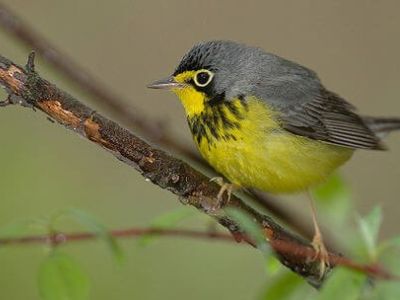B-CAWA-Canada Warbler

Canada Warbler
Cardellina canadensis
- Phylum: Craniata
- Class: Aves
- Order: Passeriformes
- Family: Parulidae
The Canada warbler (Cardellina canadensis) is a small boreal songbird of the New World warbler family. It summers in Canada and northeastern United States and winters in northern South America.
General Information
Key Habitat Features
Deciduous dominated forests (Birch, aspen, mature spruce and balsam poplar stands) wet sites or riverside slopes.
Forests with a dense, deciduous shrub layer, complex understory, and available perch trees.
Nest on or near the ground in mossy logs or stumps, streambanks, grassy hummocks.
Mature deciduous upperslope forest in the Fort Nelson lowlands.
Objectives
Minimize disturbance during the breeding season.
Maintain nesting habitat throughout all seasons.
Maintain desired plant communities and key habitat features.
Planning and Operational Measures
All Activities
Identify key habitat features using appropriate measures (i.e. QP direction, desktop review, field confirmation, etc) and plan activities within the operating area accordingly.
Within identified habitat, maintain patches of intact structurally complex deciduous-leading forests >4 hectares.
Within riparian areas, retain the RMA where possible. Retaining generous riparian corridors (i.e., riparian management areas) of suitable habitat may help retain connectivity at the landscape level.
Time works such that they occur outside of the critical timing window.
All Activities
Undertake construction and operation of oil and gas activities in a manner that minimizes impacts to desired plant communities and key habitat features.
Seismic
Minimize impacts to ground and understory.
Maintain structural complexity of forested areas.
Timing considerations when working within identified habitat:
Avoid disturbance and/or clearing activities during the critical timing window from May 1 to July 31.